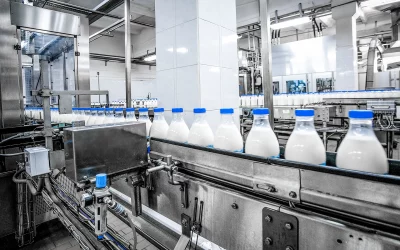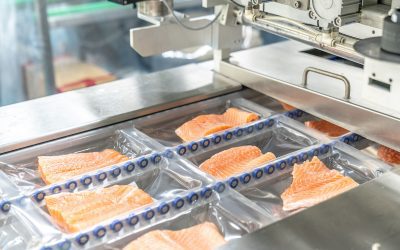What are the most common forms of slitting/converting?
Before you are able to select the correct type of knife for your particular context/application, it’s important to have a solid grasp of the most common forms of slitting.
We’ve set the most common slitting processes used for converting materials below.
Razor slitting
Razor slitting is a process that’s commonly used to convert films, plastics, tapes, vinyls and ribbons.
The blades normally used in the razor slitting process tend to be inexpensive and have shorter life cycles than other types of converting knives. Razor slitting blades will typically be mounted to a bar and will remain stationary during the slitting process.
It’s worth noting that the razor slitting process can involve the use of anywhere between one and 120 blades – where material is conveyed across multiple blades on a single bar in order to be cut (the number of blades is normally determined based on the width of the material to be cut).
Shear slitting
Another one of the most common processes used in the converting industry is shear slitting.
Shear slitting is used in applications that require precision cuts. However, shear slitting does tend to be more complex and expensive to set up than other slitting methods.
Shear slitting is typically used to convert heavy films, foils, paper, composites and layered materials.
Shear slitting requires the use of two separate blades; a top blade known as a ‘male knife’ and a bottom blade known as a ‘female knife’ (or anvil). The male knife is adjusted at the cant angle so that the two blades come into contact at what is known as the ‘nip point’ – similar to the way a pair of hand scissors functions.
As you have probably already guessed, achieving the longest blade life in shear slitting applications requires appropriately setting this ‘nip point’. Should the nip point not be set correctly, the blades will wear inordinately quickly.
As shear slitting generates only a small amount of heat, appropriately set up blades can last for a long time.
Scoring/crush cut slitting
The third most common process used in the converting industry is scoring/crush cut slitting.
Crush cut slitting is used to separate thick, tough, non-woven materials, laminates, paper and fabrics. This process creates a ‘ragged edge’ which results in rolls that are both thicker on the inside and more narrow on the outside of the roll.
Crush cut slitting tends to result in poor edge quality, BUT this is balanced by the fact that it’s easy to set up and requires relatively inexpensive parts compared to other converting processes.
In the crush cut slitting method the knife is held in place by a pneumatic holder and is activated via air pressure. The scoring process itself involves the knife pressing into the material and being run against a hardened edge (the anvil).
The best blade materials for each converting process
Now that we’ve seen what the main converting processes are, let’s next take a look at the best blade materials for each process.
This will help you to select the optimum blade for your particular use case.
The best blade materials for razor slitting
When it comes to razor slitting, the best material for a blade will depend upon the type of material being cut and the needs of your business.
When you are only dealing with short runs, lower grade blade materials such as carbon steel and stainless steel are suitable.
However, if you intend to undertake long runs and want to decrease factors such as downtime and maintenance, you should choose blades manufactured from tungsten carbide.
The best blade materials for shear slitting
If you’re going to be undertaking shear slitting, then there are a number of materials which will work best for this particular use case.
D2 steel tends to be the most common steel used for shear slitting processes, however in ‘tougher’ scenarios where wear is expected to be more severe, you’ll find M2 steel, carbide inlaid steel, and CPM 10V steel used as this increases blade life.
The best blade materials for scoring/crush slitting
When it comes to selecting the blade materials for scoring/crush slitting it’s important not to overlook the material that’s used for the anvil too. Why? Because the anvil is more expensive to replace than the blade.
When it comes to selecting the material for the blade, you should look at 52-100 steel or M2 steel.
What are the most common types of knives in the converting industry?
In addition to looking at the most common converting processes, and the materials most suited to them, it’s important to consider the types of knives that are most suitable.
You’ll find these in more detail below.
Bag production blades
Bag production blades are used to cut and produce packaging bags. At MRMK our bag production blades are available with a variety of tooth forms with razor sharp teeth and endless coating options.
Bottom knives
MRMK produces a wide variety of bottom knives which are compatible with many different types of food production machines.
MRMK’s bottom knives are manufactured from high-grade Sheffield steel and are available with shaft locking options and fast lead times.
Crush cutters
At MRMK our range of crush cutters includes blades with sharp or rounded edges that can easily cut through the toughest of materials including sandpaper, rubber, laminates and even adhesive materials.
Choose MRMK for your converting knife requirements
No matter what your converting knife requirements, MRMK has you covered. Manufactured in the heart of Sheffield’s historic steel-making district, MRMK’s converting knives include bag production blades, bottom knives, crown punches, crush cutters, die cutters, dished knives and more.
Explore MRMK’s range of converting knives today
Find out more about industrial knife blades on the MRMK news and insights hub…
When to Replace Your Industrial Machine Blades | The Ultimate Guide to Blade Coatings and Their Benefits | Made in Sheffield: A History of Knife Making and Steel in Sheffield


